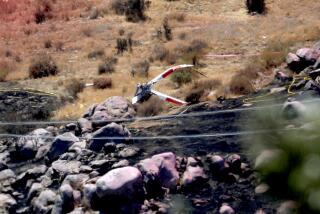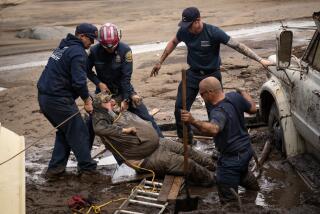Rescue Device Proves a Cinch in Four Tries : Flood: Anguished over a Woodland Hills teen-ager’s death in the Los Angeles River three years ago, helicopter pilot Rick Cearley designed a collar that has saved Ventura River victims.
Because he could not forget seeing a Woodland Hills teen-ager die in raging floodwaters nearly three years ago, Rick Cearley saw four others saved when floodwaters returned this week.
Haunted by visions of 15-year-old Adam Bischoff being swallowed by the Los Angeles River, Cearley, a helicopter pilot for the Los Angeles County Fire Department, set out to design a device to save others caught in similar disasters.
Cearley’s ingenuity paid off this week as he watched rescue workers pluck victims from the storm-swollen Ventura River with “The Cinch,” a bright yellow collar that can be fitted under victims’ arms and tightened around their upper bodies, allowing them to be airlifted to safety.
“I was glad to see it,” said Cearley of the successful use of his new device.
In February, 1992, television cameras caught Adam’s panic-stricken face as he struggled unsuccessfully to stay above the turbulent waters of the Los Angeles River during a winter rainstorm.
Firefighters and police officers chased Adam along the channel but their rescue efforts were hampered by floating debris, a 35 m.p.h. current that swept the boy from Woodland Hills to Reseda in under an hour and his inability to grab ropes, garden hoses and inflatable rafts that were tossed to him.
Seeing the need for a more versatile rescue device, Cearley created the cinch, which can be used in swift-water rescues as well as land rescues from cliffs or high-rise buildings.
Ventura County Sheriff’s Lt. Dave Tennessen said his department’s search and rescue unit used Cearley’s cinch collar Tuesday to pull four people from the Ventura River.
“Just the day before the rescues, we were out training with the thing,” Tennessen said.
Other Southern California public safety agencies are also embracing Cearley’s device, which was patented last January.
The Los Angeles County Fire Department and the Los Angeles Police Department began training employees with the cinch last year and the city’s Fire Department is evaluating the device for possible use.
LAPD Lt. Keith Johnson, who heads the swift-water rescue unit of the department’s Air Support Division, said he was not only impressed with the device’s performance this week in Ventura County, but at $175 each, the cinch costs hundreds of dollars less than competing products.
“But the real key issue is that it’s very simple to operate, yet it’s very secure” Johnson said. “When the victim is in the cinch, they’re not coming out.”
Once placed over a victim’s head and under his arms, the cinch can be tightened either by the victim’s weight or by a rescue worker pulling a D-ring, Cearley said. Once cinched around the body, it can be used to lift unconscious victims into a helicopter, unlike other similar devices, which require the victim to grasp part of the harness.
The device is being manufactured and marketed by a St. Louis-based company, said Cearley, who added he is unaware how many cinches have been sold. He declined to discuss his financial stake in the sales.
One thing he is certain of, however, is that a need exists for his device, said Cearley, who is assigned to the department’s swift-water rescue unit, flying out of Whiteman Air Park in Pacoima.
“There were other products on the market but they all left something out. Some you couldn’t get into and when you did you could fall out,” Cearley said. “I saw a need for something different.”
“I think if we could have gotten the cinch to Adam Bischoff . . . we could have saved him.”
More to Read
Sign up for Essential California
The most important California stories and recommendations in your inbox every morning.
You may occasionally receive promotional content from the Los Angeles Times.










